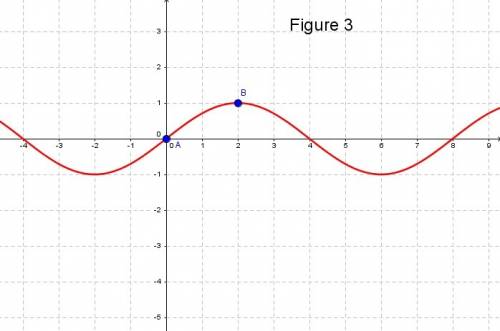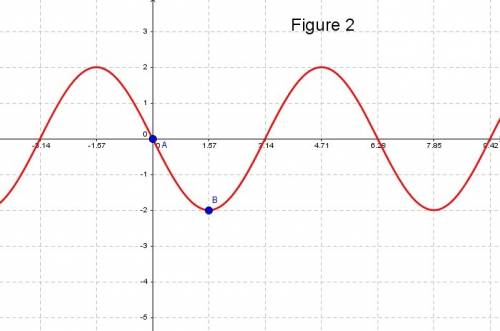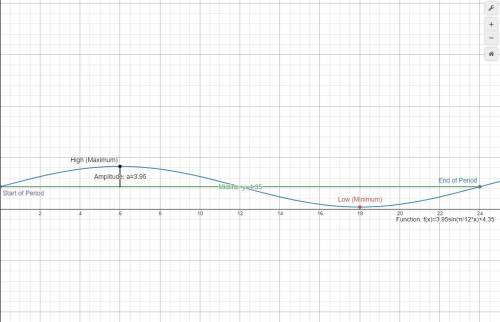



f(x)=4.35+3.95*sin( )
)
Step-by-step explanation:

Step-by-step explanation:
Recall:
Sinusoidal Function -> Amplitude ->
Amplitude ->  Period ->
Period ->  Phase Shift ->
Phase Shift ->  Vertical Shift/Midline ->
Vertical Shift/Midline -> 
Given:
Amplitude -> Period ->
Period ->  Phase Shift ->
Phase Shift ->  Vertical Shift/Midline ->
Vertical Shift/Midline -> 
Conclusion:
The equation that models the situation is 
Hope this helped! I've attached a graph of the function so you can understand it better!

f(x)=5.05 sin((pi/12)x) + 5.15
Step-by-step explanation:

 7
7 We have been given that a cosine function is a reflection of its parent function over the x-axis. The amplitude of the function is 11, the vertical shift is 9 units down, and the period of the function is  . The graph of the function does not show a phase shift. We are asked to write the equation of our function.
. The graph of the function does not show a phase shift. We are asked to write the equation of our function.
We know that general form a cosine function is  , where,
, where,
A = Amplitude,
 = Period,
= Period,
c = Horizontal shift,
d = Vertical shift.
The equation of parent cosine function is  . Since function is reflected about x-axis, so our function will be
. Since function is reflected about x-axis, so our function will be  .
.
Let us find the value of b.




Upon substituting our given values in general cosine function, we will get:

Therefore, our required function would be  .
.
 .
.
Step-by-step explanation:
Given information:
Period = 24 hr
Maximum = 16 at t=16 hr.
Minimum = 10 at t=4 hr.
The general sin function is
 .... (1)
.... (1)
where, |A| is altitude,  is period, C is phase shift and D is midline.
is period, C is phase shift and D is midline.
Period is 24 hr.

Altitude is


The function is minimum at t=4 and maximum at t=16,phase shift is

Substitute these values in equation (1).

Therefore, the required function is  .
.
 7
7 We have been given that a cosine function is a reflection of its parent function over the x-axis. The amplitude of the function is 11, the vertical shift is 9 units down, and the period of the function is  . The graph of the function does not show a phase shift. We are asked to write the equation of our function.
. The graph of the function does not show a phase shift. We are asked to write the equation of our function.
We know that general form a cosine function is  , where,
, where,
A = Amplitude,
 = Period,
= Period,
c = Horizontal shift,
d = Vertical shift.
The equation of parent cosine function is  . Since function is reflected about x-axis, so our function will be
. Since function is reflected about x-axis, so our function will be  .
.
Let us find the value of b.




Upon substituting our given values in general cosine function, we will get:

Therefore, our required function would be  .
.
 .
.
Step-by-step explanation:
Given information:
Period = 24 hr
Maximum = 16 at t=16 hr.
Minimum = 10 at t=4 hr.
The general sin function is
 .... (1)
.... (1)
where, |A| is altitude,  is period, C is phase shift and D is midline.
is period, C is phase shift and D is midline.
Period is 24 hr.

Altitude is


The function is minimum at t=4 and maximum at t=16,phase shift is

Substitute these values in equation (1).

Therefore, the required function is  .
.
 1
1 Answer:
See belowStep-by-step explanation:
To sketch the graph, you can follow these steps:
1. Choose a scale for the x-axis that ranges from 0 to 30. This represents the time in minutes for one complete rotation of the Ferris wheel.
2. Choose a scale for the y-axis that ranges from 0 to 500. This will allow you to plot the maximum height of the Ferris wheel, which is 443 feet, and the height of the Elizabeth Tower, which is 320 feet.
3. Plot the center of the Ferris wheel at (15, 246) feet.
4. Plot the highest point of the Ferris wheel at (15.66, 443) feet.
5. Plot the lowest point of the Ferris wheel at (0, 49) feet.
6. Plot the two points where the height of the Ferris wheel is equal to the height of the Elizabeth Tower, which are approximately (3.685, 320) and (8.318, 320) feet. Note that these points are obtained by solving the equation h(t) = -197cos(pi/15 t) + 246 for h(t) = 320.
7. Sketch the graph of the function h(t) = -197cos(pi/15 t) + 246 by plotting points at various times t and their corresponding heights h(t), using the equation and the values for A, B, C, and D given in the problem.
Remember to label the x-axis as "Time (minutes)" and the y-axis as "Height (feet)" and to provide a title for the graph. I hope this helps!

It will provide an instant answer!
